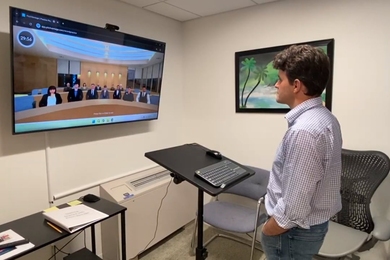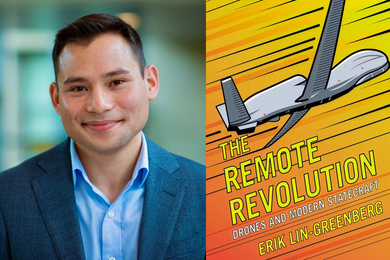Associate Professor Martha L. Gray, known for her significant contributions to understanding how physical, chemical and mechanical factors influence the growth and metabolism of living musculo skeletal tissue, is the 1993 recipient of the Harold E. Edgerton Award.
The annual award honors a junior faculty member for distinction in teaching, research and service to the MIT community. The announcement was made at the April 20 faculty meeting.
Professor Gray, who joined the faculty in 1987, holds a joint appointment in the Department of Electrical Engineering and Computer Science and the Harvard-MIT Division of Health Sciences and Technology.
"Martha Gray is a fabulous, dedicated, talented and insightful teacher in both her HST and her EECS subjects," the selection committee said in the citation read by Professor Julio J. Rotemberg of the Sloan School, who chaired the committee."She is viewed by many as the HST faculty member who has been most successful in integrating quantitative concepts into the teaching of cell pathophysiology. She is also a superb teacher in core EECS, where she has also introduced much innovative material.
"For instance, she showed students in the common-core electronics subject 6.002 that respiration and blood concentration in blood are first-order processes so that the mathematics that the students had learned for RC [resistor-capacitor] circuits had interesting biological applications. She even brought equipment to class so that students could stay after class to determine their lungs' RC-model parameters. Her extraordinary teaching in EECS led her to win the Joel Spira Teaching Award in 1992."
Dr. Gray, the J.W. Kieckhefer Associate Professor of Electrical Engineering, received the BS degree in computer science from Michigan State University (1977) and enrolled in HST's Medical Engineering and Medical Physics Program, obtaining her SM in EECS (1981) and her PhD in medical engineering (1986). She won a NASA postdoctoral fellowship which took her to SUNY Stonybrook. She returned to MIT as the Kieckhefer Professor in 1987 and was promoted to associate professor in 1992.
"A quantitative understanding of the mechanism used by cells to sense and respond to their physical environment is of enormous importance in a wide variety of organ systems," the selection committee said. "Martha has chosen to study cartilage and bone-tissues which are of critical importance to such common and debilitating diseases as arthritis, osteoporois and fractures. Her research demands expertise in an unusually wide range of disciplines including cell biology, biochemistry and both electrical and mechanical engineering. She has become internationally recognized for her unusual strength in both the engineering and the biological disciplines."
The selection committee cited Professor Gray's extensive service to the MIT community.
"On the HST side, she is a counselor for Medical Engineering and Medical Physics (MEMP) graduate students; she serves on the HST graduate committee, the faculty search committee for Speech and Hearing Sciences, and the MD curriculum committee, and recently she assumed responsibility for a small committee to review the MEMP curriculum and degree requirements. On the EECS side, she is one of the few faculty who serves both as an undergraduate advisor and a graduate counselor. In addition she is on the EECS advisory committee. Finally, she is on the Institute's Athletic Board.
"There are many very talented young faculty members at MIT. Our committee has had the pleasure and the privilege of reviewing the accomplishments of some of the best of these. Having done so, we believe that none is more worthy of receiving the 1994-95 Harold E. Edgerton Award than Martha L. Gray."
Serving on the selection committee with Professor Rotemberg were Professors Lorna J. Gibson of Civil and Environmental Engineering, Thomas A. Herring of Earth, Atmospheric and Planetary Sciences, and David M. Parks of Mechanical Engineering.
The award, carrying a $5,000 honorarium, was established in 1983 with contributions by the faculty in honor of Professor Harold E. (Doc) Edgerton, who died in 1990.
A version of this article appeared in the April 27, 1994 issue of MIT Tech Talk (Volume 38, Number 30).





